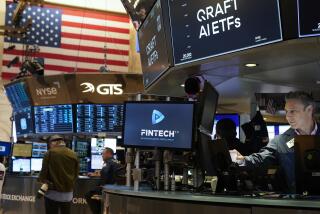ETFs see demand, credibility on the rise
- Share via
NEW YORK — Stan Harris has bought mutual funds for years, but he doesn’t invest the way he once did.
The Florida retiree hasn’t become bearish. But instead of relying on traditional mutual funds, Harris is turning to exchange-traded funds.
“If ETFs had been around, and as popular as they are now, some time ago I probably would have constructed my entire portfolio around them,” said Harris, 77, a former foreign service officer with the State Department.
ETFs are mutual funds that simply track broad or narrow market indexes, and trade like stocks. They have become one of the hottest investments to emerge from Wall Street in recent years.
Assets jumped 43% last year to $432 billion, while the number of funds has shot up 91%, according to research firm Morningstar Inc. There were 51 ETFs in 2000. Today, there are 380.
“I don’t see any letup in demand,” said James Pacetti, president of consulting firm ETF International Associates Inc. in New York.
ETFs emerged in the 1990s as an alternative to traditional mutual funds. ETFs resemble index funds but typically have lower management fees. And although mutual fund prices are set once a day, ETF prices fluctuate throughout the trading day like stocks -- allowing investors to react more quickly to trends.
Most traditional stock funds choose from a broad menu of companies and industries, looking for shares across sectors that are expected to show growth or appear undervalued. The first ETF was based on the Standard & Poor’s 500 index, but since then, investment companies have increasingly devised ETFs that are tied to small groupings of stocks.
One ETF invests only in clean-energy companies, and another targets small firms in Japan. There is even an ETF for companies developing applications for nanotechnology, the science of dealing with super-tiny particles or structures.
ETFs can also provide an easy way to invest in commodities, which were once off-limits to all but the most sophisticated investors. People may be wary of buying and storing gold themselves, but they can buy an ETF that owns gold and make a bet on its price that way.
In a sign of the growing mainstream credibility of ETFs, several financial services firms are working to adapt ETFs to 401(k) retirement plans. Though few 401(k)s offer ETFs, that may change in the next few years, experts say.
But investment pros also recommend caution with ETFs because much of the recent growth has come from exotic offerings that make bets on such things as currency and commodity prices.
The new breed often lacks the low costs and other merits of traditional ETFs, and could subject investors to big risks if the markets turn against them.
“Some of the newer ETFs don’t live up to the good ETF name,” said Michael Iachini, director of mutual fund research at the Schwab Center for Investment Research.
Ravi Malik, a professional money manager who lives in Beverly Hills, frequently buys ETFs in his personal account at E-Trade Financial, including sector and single-country international funds. But he worries that the ready availability of risky ETFs could result in big losses for unsophisticated individual investors.
“It just makes it too easy and might make it a little dangerous,” Malik said.
Proponents say the new ETFs let individuals dabble in potentially profitable corners of the financial markets that might otherwise be off-limits, either because of the effort required to research individual companies or because there was no easy way for them to trade things such as currencies.
They also say the new ETFs are geared primarily at professionals and experienced individual investors.
“If anybody came to me off the street who wasn’t a sophisticated investor and said, ‘Which [ETF] would you recommend?,’ it wouldn’t be one of the more sophisticated,” said Bruce Bond, president of PowerShares Capital Management, an ETF company based in Wheaton, Ill.
ETF companies are rushing out new products in hopes of tapping into the recent ardor for alternative investments, which have notched strong returns recently.
There also is a big push to be the first ETF provider in any market sector because such initial offerings tend to attract the most investors.
The StreetTracks Gold Trust ETF that was started in November 2004, for example, has almost $9 billion in assets, while the IShares Comex Gold Trust started two months later has only $891 million.
“Once a product is made available, it’s very difficult for someone to step into the marketplace to compete,” said Tim Meyer, ETF business manager at Rydex Investments in Rockville, Md.
A key feature in some new ETFs is the use of leverage, which means that investors will experience greater gains, or losses, than the underlying stocks in the portfolios.
For example, Iachini pointed out that the ProFund Advisors’ ProShares Ultra S&P; 500 ETF gains or loses $2 for every $1 movement in the index. The ProShares Short Dow 30 rises $1 when the Dow Jones industrial average falls $1 and vice versa.
Despite the benefits of traditional ETFs, they have been slow to break into 401(k) plans because of structural impediments revolving around trading and record-keeping issues.
For example, 401(k) plans process trades at the end of each day, and most aren’t set up to handle ETFs, which trade throughout the day, said Steve Ferber, executive vice president at Phoenix-based AST Trust Co.
AST and others have come up with systems to get around the problems, and some experts think ETFs could become widely available in retirement plans.
“ETFs going into 401(k)s is inevitable,” Bond said.
More to Read
Inside the business of entertainment
The Wide Shot brings you news, analysis and insights on everything from streaming wars to production — and what it all means for the future.
You may occasionally receive promotional content from the Los Angeles Times.










